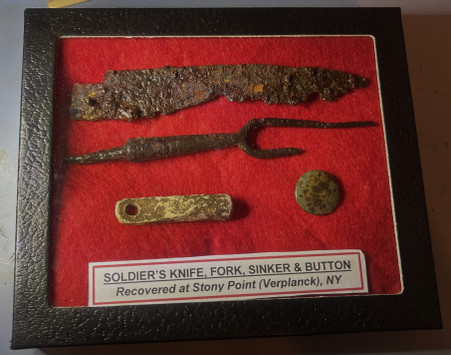 Loading... Please wait...
Loading... Please wait...-
Call us on (973) 810-2976
- My Account
- Gift Certificates
- Items / $0.00
All prices are in All prices are in USD
Categories
- Home
- NEW ITEMS
- Revolutionary War soldier’s knife, fork, sinker and button, recovered at Stony Brook, NY
- Home
- Identified Artifacts
- Revolutionary War soldier’s knife, fork, sinker and button, recovered at Stony Brook, NY
- Home
- Excavated Artifacts
- Revolutionary War soldier’s knife, fork, sinker and button, recovered at Stony Brook, NY
- Home
- Personal Items
- Revolutionary War soldier’s knife, fork, sinker and button, recovered at Stony Brook, NY
- Home
- Late 18th Century / Early 19th Century
- Revolutionary War soldier’s knife, fork, sinker and button, recovered at Stony Brook, NY
- Home
- Revolutionary War items
- Revolutionary War soldier’s knife, fork, sinker and button, recovered at Stony Brook, NY
Revolutionary War soldier’s knife, fork, sinker and button, recovered at Stony Brook, NY
Product Description
This Revolutionary War grouping was recovered in the 1980s by the late Dean Thomas at the Battle site of Stony Point NY - July 16-19, 1779. The remains of the knife and fork measure approximately 5” long each. The fishing sinker was made from melted lead bullets, and the brass button has the “pyramid” attachment, associated with French buttons.
This area connected Verplanck’s Point on the east side of the Hudson River, with Stony Point on the west side. Since the British controlled New York City for most of the war, This area was the southernmost crossing point for American soldiers and supplies. It was also a very important communication line, therefore a very strategic target for the British.
In March of 1777, five hundred British soldiers landed at Lent’s Cove on their way to attack Peekskill, where the British burned military supplies and destroyed quite a bit of property. In October 1777, General Clinton again dispersed the American forces at Verplanck’s Point and landed 3,000 troops to secure the area for an attack up river.
On the highest ground at Verplanck, just east of Kings Ferry, the building of Fort Lafayette started in the spring of 1778 and finished in May 1779 as a modest four-gun earthwork. The British landed 6,000 troops and captured it in June of 1779 in connection with operations at Stony Point.
In 1781, the Continental Army of General George Washington encamped at Verplanck's Point as a staging area for crossing the Hudson River at Kings Ferry. Pursued by the army of British General William Howe, it crossed to Stony Point on the west bank, enroute to Fort Lee, New Jersey. From there it headed south, beginning the long march to Yorktown, Virginia, where Washington received the surrender of General Charles Cornwallis on October 19, 1781.
This is a very unique grouping and Dean recovered them in the same hole, indicating it probably belonged to a single soldier. They come in the glass top display case pictured.
Revolutionary War artifacts have always been difficult to find. With the upcoming of the 250th anniversary of the nation's founding next year, there will be a revitalized interest. Just about all Revolutionary War relics and artifacts will be in demand, which will only add to their scarcity and price. I am already seeing a substantial surge in sales.



